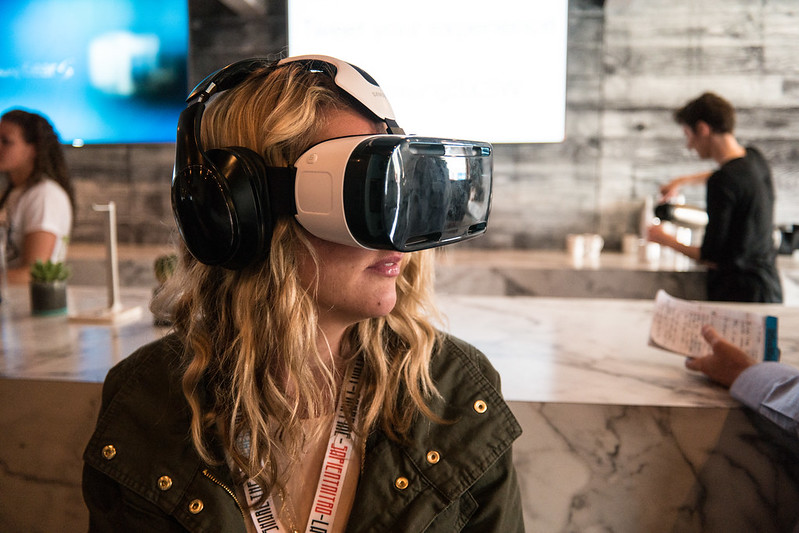
People often focus on the positives of virtual reality (VR): It can provide more immersive experiences. Players can visit outer space or a foreign country without ever leaving their couches. They can interact with other gamers in those virtual worlds. But VR enthusiasts often overlook, or never know about, VR’s darker sides: namely, the risk of unwanted interactions, which falls disproportionately on women and people of color.
Concern around the metaverse buzzed recently after a female beta tester said a stranger groped her while interacting on Virtual Horizons, a metaverse platform operated by Meta, Facebook’s umbrella company. Meta’s internal review indicated the woman should have used the built-in “Safe Zone” security features.
In another case, researchers examined 11.5 hours of footage from VR chat, an application used in Facebook’s metaverse. Researchers identified 100 possible violations of the company’s VR policies in that span. They included bullying and sexual harassment, as well as the grooming of minors. The team concluded these incidents happened about every seven minutes.
But while the metaverse is a new horizon for most online gamers, virtual sexual harassment is not a new issue. In one firsthand account of VR harassment from 2016, a woman reported that while she navigated a virtual world, another player groped her chest and crotch, and chased her around the game, even after she told him to stop.
Another woman who tested the metaverse for Facebook said that while she did not get harassed, she felt uncomfortable in the virtual world. She also believed it’d be difficult to moderate what happened in it. Instead of only screening text or images, moderators would have to look at aspects like in-game gestures and how people’s avatars moved.
In a recent poll, 65 percent of online gamers experienced severe online harassment. The amount rose to 74 percent for people engaging in multiplayer games. Of those, more than half received targeted harassment, including related to their gender or identity—stressing the importance in particular to create safe spaces for trans women who play VR, especially since virtual environments can have benefits for trans people. Many find it empowering because they can make avatars that reflect their true selves, even before coming out. However, bullying would outweigh any uplifting experiences.
One way to ensure women’s safety in the metaverse is to encourage women to enter the tech field, helping close the gender gap. Dr. Tarika Barrett is the CEO of Girls Who Code, which has served more than 450,000 students worldwide. “We want to empower girls to shift the status quo,” said Barrett, “to pursue careers in tech and wield them as a force for good in the world, while also proudly building an exciting future for themselves.”
VR Headsets More Likely to Cause Nausea in Women
Women may even be at a disadvantage in VR due to the required headsets. An informal survey found female VR players much more likely to experience nausea than their male counterparts: While 22.6 percent of women felt nauseated frequently while playing VR, only 7.2 percent of men reported the same. An academic paper showed many VR headsets do not offer enough adjustments for the distance between a players’ eyes, known as interpupillary distance (IPD). VR headsets allow people to alter the IPD by changing the distance between each VR lens they look through while playing. The author suggested the headsets may not accommodate female face structures, causing sickness while playing.
Working for Positive Change
Despite the dark sides of VR, many people are working to make virtual reality more gender-balanced and safer for everyone. Maria Korolov is the founder and president of Women in Virtual Reality (WiVR), a networking and industry resource focused on females in the sector.
Jenn Duong is another enduring supporter of improved diversity in VR. She was a co-founder for SH//FT, an organization that supports equality and inclusion in future technologies. While discussing VR creativity and inspiration, Duong said, ”Do not be afraid to experiment, and do not be afraid to fail. If we don’t do projects because we’re worried about the technology not being there or that what we are making isn’t good, we failed automatically because we didn’t even try. There is a lesson to be learned in every effort in VR. So if you have something you want to make, just do it. ”
There’s also Equal Reality, an organization that uses VR simulations to run diversity inclusion training sessions and encourage more empathy in participants.
Awareness Is the First Step
There’s certainly impressive progress in making VR more supportive of and accessible for women. However, people must continue to raise awareness of the darker matters and put pressure on those who have the power to enact change. Only then can we make sustained improvements that change the tech and the world for good.
Up next:





